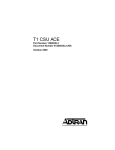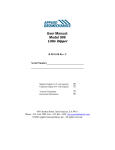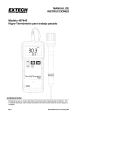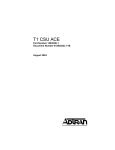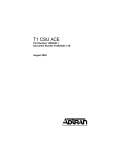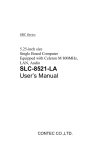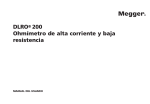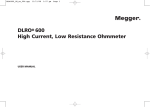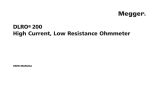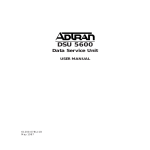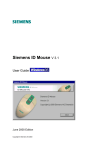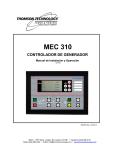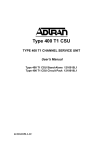Download T1 CSU ACE (2nd Gen) User Manual
Transcript
T1 CSU ACE Part Number 1202022L1 Document Number 61202022L1-1B September 2000 901 Explorer Boulevard P.O. Box 140000 Huntsville, AL 35814-4000 (256) 963-8000 2000 ADTRAN, Inc. All Rights Reserved Printed in U.S.A. FCC regulations require that the following information be provided in this manual: 1. 2. This equipment complies with Part 68 of the FCC rules. On the bottom of the equipment housing is a label that shows the FCC Registration Number and Ringer Equivalence Number (REN) for this equipment. If requested, provide this information to the telephone company. REN is not required for some types of analog or digital facilities. If this equipment causes harm to the telephone network, the telephone company may temporarily discontinue service. If possible, advance notification is given; otherwise, notification is given as soon as possible. The telephone company will advise the customer of the right to file a complaint with the FCC. 3. The telephone company may make changes in its facilities, equipment, operations or procedures that could affect the proper operation of this equipment; advance notification and the opportunity to maintain uninterrupted service is given. 4. If experiencing difficulty with this equipment, please contact ADTRAN for repair and warranty information. The telephone company may require this equipment to be disconnected from the network until the problem is corrected, or it is certain the equipment is not malfunctioning. 5. This unit contains no user-serviceable parts. 6. An FCC compliant telephone cord with a modular plug is provided with this equipment. This equipment is designed to be connected to the telephone network or premises wiring using an FCC-compatible modular jack, which is Part 68-compliant. 7. The following information may be required when applying to the local telephone company for leased line facilities. Service Type 1.544 MB/S Digital Interface SF 1.544 MB/S Digital Interface ESF 1.544 MB/S Digital Interface ESF with B8ZS 8. Digital Facility Interface Code 04DU9-BN 04DU9-DN 04DU9-1KN 04DU9-1SN Service Order Code 6.0N Network Jacks RJ48C In case of equipment malfunction, all repairs must be performed by ADTRAN or an authorized agent. It is the responsibility of users requiring service to report the need for service to ADTRAN or one of our authorized agents. Service can be facilitated through our office. See the back page of this manual for the address and phone numbers. iii Federal Communications Commission Radio Frequency Interference Statement This equipment has been tested and found to comply with the limits for a Class B digital device, pursuant to Part 15 of the FCC Rules. This device complies with Part 15 of the FCC rules. Operation is subject to the following two conditions: 1. This device may not cause harmful interference, 2. This device must accept any interference received, including interference that may cause undesired operation. . No changes or modifications to this unit are allowed unless expressly approved by the party responsible for compliance. Modifications could void the user's authority to operate the equipment within the FCC rules. Canadian Emissions Requirements This digital apparatus does not exceed the Class B limits for radio noise emissions from digital apparatus, as set out in the interferencecausing equipment standard entitled “Digital Apparatus,” ICES-003 of the Department of Communications. Cet appareil nuerique respecte les limites de bruits radioelectriques applicables aux appareils numeriques de Class A prescrites dans la norme sur le materiel brouilleur: “Appareils Numeriques,” NMB-003 edictee par le ministre des Communications. iv Canadian Equipment Limitations Notice: The Canadian Industry and Science Canada label identifies certified equipment. This certification means that the equipment meets certain telecommunications network protective, operational, and safety requirements. The Department does not guarantee the equipment will operate to the user’s satisfaction. Before installing this equipment, users should ensure that it is permissible to be connected to the facilities of the local telecommunications company. The equipment must also be installed using an acceptable method of connection. In some cases, the company’s inside wiring associated with a single line individual service may be extended by means of a certified connector assembly (telephone extension cord). The customer should be aware that compliance with the above limitations may not prevent degradation of service in some situations. Repairs to certified equipment should be made by an authorized Canadian maintenance facility designated by the supplier. Any repairs or alterations made by the user to this equipment, or equipment malfunctions, may give the telecommunications company cause to request the user to disconnect the equipment. Users should ensure for their own protection that the electrical ground connections of the power utility, telephone lines and internal metallic water pipe system, if present, are connected together. This precaution may be particularly important in rural areas. Users should not attempt to make such connections themselves, but should contact the appropriate electric inspection authority, or an electrician, as needed. The Load Number (LN) assigned to each terminal device denotes the percentage of the total load to be connected to a telephone loop which is used by the device, to prevent overloading. The termination on a loop may consist of any combination of devices subject only to the requirement that the total of the Load Numbers of all devices does not exceed 100. v IMPORTANT SAFETY INSTRUCTIONS When using telephone equipment, please follow these basic safety precautions to reduce the risk of fire, electrical shock, or personal injury. 1. Do not use this product near water, such as a bathtub, wash bowl, kitchen sink, laundry tub, in a wet basement, or a swimming pool. 2. Avoid using a telephone (other than a cordless type) during an electrical storm. There is a remote risk of shock from lightning. 3. Do not use the telephone to report a gas leak in the vicinity of the leak. 4. Use only the power cord, power supply, and/or batteries indicated in the manual. Do not dispose of batteries in a fire. They may explode. Check with local codes for special disposal instructions. SAVE THESE INSTRUCTIONS Warranty and Customer Service ADTRAN will replace or repair this product within five years from the date of shipment if it does not meet its published specifications or fails while in service. For detailed warranty, repair, and return information refer to the ADTRAN Equipment Warranty and Repair and Return Policy Procedure on the last page of this manual. Return Material Authorization (RMA) is required prior to returning equipment to ADTRAN. For service, RMA requests, or further information, contact one of the numbers listed on the last page of this manual. vi Affidavit for the Connection of Customer premises Equipment to the 1.544 Mbps and /or Subrate Digital Services. For work to be performed in the certified territory of: Telco’s Name:_______________________________________ State of: ____________________________________________ Country of: _________________________________________ I, ___________________________________, of _________________ (Name of Authorized Representative) (Customer Name) ______________________________________, ____________________ (Customer’s Address) (Telephone Number) being duly sworn, state: I have responsibility for the operation and maintenance of the terminal equipment to be connected to__________1.544 Mbps and/or ________Subrate digital services. The terminal equipment to be connected complies with part 68 of the commissions rules except for the encoded analog content and billing protection specifications. With respect to encoded analog content and billing protection: • I attest that all operations associated with the establishment, maintenance and adjustment of the digital CPE with respect to encoded analog content and encoded billing information continuously complies with Part 68 of the FCC’s Rules and Regulations. • The digital CPE does not transmit digital signals containing encoded analog content or billing information which is intended to be decoded within the telecommunications network. • The encoded analog and billing protection is factory set and is not under the control of the customer. I attest that the operator(s) maintainer(s) of the digital CPE responsible for the establishment, maintenance and adjustment of the encoded analog content and billing information has (have) been trained to perform vii these functions by successfully completing one of the following: Check appropriate ones(s): ( ) A. A training course provided by the manufacturer/ grantee of the equipment used to encode analog signals; or ( ) B. A training course provided by the customer or authorized representative, using training materials and instructions provided by the manufacturer/grantee of the equipment used to encode signals; or ( ) C. An independent training course (e.g., trade school or technical institution) recognized by the manufacturer/ grantee of the equipment used to encode analog signals; or ( ) D. In lieu of the proceeding training requirements, the operator(s) maintainer(s) is (are) under the control of a supervisor trained in accordance with _____________above. I agree to provide ______________________ with proper documentation__________________________________(Telco’s Name) to demonstrate compliance with the information as provided in the proceeding paragraph, if so requested. _________________________ (Signature) _________________________ (Title) _________________________ (Date) Subscribed and sworn to before me this day______, month______, year__________. ___________________________ (Notary Public) My commission expires: ____________________ viii LIMITED PRODUCT WARRANTY ADTRAN warrants that for five (5) years from the date of shipment to Customer, all products manufactured by ADTRAN will be free from defects in materials and workmanship. ADTRAN also warrants that products will conform to the applicable specifications and drawings for such products, as contained in the Product Manual or in ADTRAN's internal specifications and drawings for such products (which may or may not be reflected in the Product Manual). This warranty only applies if Customer gives ADTRAN written notice of defects during the warranty period. Upon such notice, ADTRAN will, at its option, either repair or replace the defective item. If ADTRAN is unable, in a reasonable time, to repair or replace any equipment to a condition as warranted, Customer is entitled to a full refund of the purchase price upon return of the equipment to ADTRAN. This warranty applies only to the original purchaser and is not transferable without ADTRAN's express written permission. This warranty becomes null and void if Customer modifies or alters the equipment in any way, other than as specifically authorized by ADTRAN. EXCEPT FOR THE LIMITED WARRANTY DESCRIBED ABOVE, THE FOREGOING CONSTITUTES THE SOLE AND EXCLUSIVE REMEDY OF THE CUSTOMER AND THE EXCLUSIVE LIABILITY OF ADTRAN AND IS IN LIEU OF ANY AND ALL OTHER WARRANTIES (EXPRESSED OR IMPLIED). ADTRAN SPECIFICALLY DISCLAIMS ALL OTHER WARRANTIES, INCLUDING (WITHOUT LIMITATION), ALL WARRANTIES OF MERCHANTABILITY AND FITNESS FOR A PARTICULAR PURPOSE. SOME STATES DO NOT ALLOW THE EXCLUSION OF IMPLIED WARRANTIES, SO THIS EXCLUSION MAY NOT APPLY TO CUSTOMER. In no event will ADTRAN or its suppliers be liable to Customer for any incidental, special, punitive, exemplary or consequential damages experienced by either Customer or a third party (including, but not limited to, loss of data or information, loss of profits, or loss of use). ADTRAN is not liable for damages for any cause whatsoever (whether based in contract, tort, or otherwise) in excess of the amount paid for the item. Some states do not allow the limitation or exclusion of liability for incidental or consequential damages, so the above limitation or exclusion may not apply to Customer. ix x Table of Contents List of Figures . . . . . . . . . . . . . . . . . . . . . . . . . . . . . . . . . . . . . . . . . . xiii List of Tables . . . . . . . . . . . . . . . . . . . . . . . . . . . . . . . . . . . . . . . . . . . . xv Chapter 1 General . . . . . . . . . . . . . . . . . . . . . . . . . . . . . . . . . . . . . Unit Overview . . . . . . . . . . . . . . . . . . . . . . . . . . . . . . . . . . . . . . . . . . Power Options . . . . . . . . . . . . . . . . . . . . . . . . . . . . . . . . . . . . . . . . . . Alarms . . . . . . . . . . . . . . . . . . . . . . . . . . . . . . . . . . . . . . . . . . . . . . . . . Loopback . . . . . . . . . . . . . . . . . . . . . . . . . . . . . . . . . . . . . . . . . . . . . . . Line Build Out . . . . . . . . . . . . . . . . . . . . . . . . . . . . . . . . . . . . . . . . . . 1-1 1-1 1-3 1-4 1-5 1-6 Chapter 2 Installation . . . . . . . . . . . . . . . . . . . . . . . . . . . . . . . . . . 2-1 Setting the LBO switch positions. . . . . . . . . . . . . . . . . . . . . . . . . . . 2-1 Powering the Unit . . . . . . . . . . . . . . . . . . . . . . . . . . . . . . . . . . . . . . . 2-2 Connecting to The Network and CPE. . . . . . . . . . . . . . . . . . . . . . . 2-4 Test and Monitor Access. . . . . . . . . . . . . . . . . . . . . . . . . . . . . . . . . . 2-5 Monitor Jacks . . . . . . . . . . . . . . . . . . . . . . . . . . . . . . . . . . . . . . . . . . 2-5 Break-and-Test Jacks . . . . . . . . . . . . . . . . . . . . . . . . . . . . . . . . . . . . 2-6 Wall Mounting . . . . . . . . . . . . . . . . . . . . . . . . . . . . . . . . . . . . . . . . . . 2-7 Chapter 3 Troubleshooting and Maintenance . . . . . . . . . . . . . 3-1 Troubleshooting . . . . . . . . . . . . . . . . . . . . . . . . . . . . . . . . . . . . . . . . . 3-1 Power . . . . . . . . . . . . . . . . . . . . . . . . . . . . . . . . . . . . . . . . . . . . . . . . 3-1 Network LOS . . . . . . . . . . . . . . . . . . . . . . . . . . . . . . . . . . . . . . . . . . 3-1 Equipment LOS . . . . . . . . . . . . . . . . . . . . . . . . . . . . . . . . . . . . . . . . 3-2 Power On - Self Check Failure . . . . . . . . . . . . . . . . . . . . . . . . . . . . 3-2 EPROM Checksum Failure . . . . . . . . . . . . . . . . . . . . . . . . . . . . . . 3-2 Maintenance . . . . . . . . . . . . . . . . . . . . . . . . . . . . . . . . . . . . . . . . . . . . 3-2 Chapter 4 Specifications . . . . . . . . . . . . . . . . . . . . . . . . . . . . . . . . 4-1 Network and Customer Interface . . . . . . . . . . . . . . . . . . . . . . . . . . 4-1 Line . . . . . . . . . . . . . . . . . . . . . . . . . . . . . . . . . . . . . . . . . . . . . . . . . . 4-1 Data Rate . . . . . . . . . . . . . . . . . . . . . . . . . . . . . . . . . . . . . . . . . . . . . . 4-1 Signal Format . . . . . . . . . . . . . . . . . . . . . . . . . . . . . . . . . . . . . . . . . . 4-1 Output Amplitude . . . . . . . . . . . . . . . . . . . . . . . . . . . . . . . . . . . . . 4-1 Network Connector Type . . . . . . . . . . . . . . . . . . . . . . . . . . . . . . . . 4-1 61202022L1-1 T1 CSU ACE User Manual xi Table of Contents Customer Interface Connector Type . . . . . . . . . . . . . . . . . . . . . . 4-1 LED Indicators . . . . . . . . . . . . . . . . . . . . . . . . . . . . . . . . . . . . . . . . . . 4-1 Power . . . . . . . . . . . . . . . . . . . . . . . . . . . . . . . . . . . . . . . . . . . . . . . . 4-1 Net LOS . . . . . . . . . . . . . . . . . . . . . . . . . . . . . . . . . . . . . . . . . . . . . . 4-1 Equip LOS . . . . . . . . . . . . . . . . . . . . . . . . . . . . . . . . . . . . . . . . . . . . 4-1 NET LB . . . . . . . . . . . . . . . . . . . . . . . . . . . . . . . . . . . . . . . . . . . . . . . 4-1 EQ LB . . . . . . . . . . . . . . . . . . . . . . . . . . . . . . . . . . . . . . . . . . . . . . . . 4-2 Power. . . . . . . . . . . . . . . . . . . . . . . . . . . . . . . . . . . . . . . . . . . . . . . . . . 4-2 Local Power . . . . . . . . . . . . . . . . . . . . . . . . . . . . . . . . . . . . . . . . . . . 4-2 Environmental . . . . . . . . . . . . . . . . . . . . . . . . . . . . . . . . . . . . . . . . . . 4-2 Temperature . . . . . . . . . . . . . . . . . . . . . . . . . . . . . . . . . . . . . . . . . . . 4-2 Relative Humidity . . . . . . . . . . . . . . . . . . . . . . . . . . . . . . . . . . . . . . 4-2 Index . . . . . . . . . . . . . . . . . . . . . . . . . . . . . . . . . . . . . . . . . . . . . . .Index-1 xii T1 CSU ACE User Manual 61202022L1-1 List of Figures Figure 1-1. Figure 1-2. Figure 1-3. Figure 1-4. Figure 1-5. Figure 1-6. Figure 2-1. Figure 2-2. Figure 2-3. 61202022L1-1 T1 CSU ACE Applications. . . . . . . . . . . . . . . . . . . . . . T1 CSU ACE Block Diagram . . . . . . . . . . . . . . . . . . . . T1 CSU ACE Power Supply . . . . . . . . . . . . . . . . . . . . T1 CSU ACE LED Alarms . . . . . . . . . . . . . . . . . . . . . . T1 CSU ACE Loopback Switch and LED . . . . . . . . . Line Build Out Switch . . . . . . . . . . . . . . . . . . . . . . . . . Power Connection . . . . . . . . . . . . . . . . . . . . . . . . . . . . T1 CSU ACE Bantam Jacks . . . . . . . . . . . . . . . . . . . . . Wall Mounting . . . . . . . . . . . . . . . . . . . . . . . . . . . . . . . T1 CSU ACE User Manual 1-1 1-2 1-3 1-4 1-5 1-6 2-3 2-5 2-7 xiii List of Figures xiv T1 CSU ACE User Manual 61202022L1-1 List of Tables Table 2-1. Table 2-2. Table 2-3. Table 2-4. 61202022L1-1 Network LBO Switch Position Settings . . . . . . . . . . Customer LBO Switch Position Settings. . . . . . . . . . Network RJ48C Connector Pin Assignments . . . . . CPE Connector Pin Assignments . . . . . . . . . . . . . . . T1 CSU ACE User Manual 2-1 2-1 2-4 2-4 xv List of Tables xvi T1 CSU ACE User Manual 61202022L1-1 Chapter 1 General UNIT OVERVIEW The ADTRAN T1 Channel Service Unit (CSU) Advanced Communications Equipment (ACE) provides the T1 interface between customer premises equipment (CPE) such as channel banks, T1 multiplexers, and the carrier network as shown in Figure 1-1. The unit complies with Part 68 of FCC Rules and with applicable sections of AT&T 62411, ANSI T1.102 and ANSI T1. 403. The unit provides functions such as surge protection, signal regeneration, alarms, loopbacks necessary for circuit operation and fault isolation as illustrated in Figure 1-2 on page 1-2. The unit is transparent to ESF or SF framing formats and AMI or B8ZS line coding. Figure 1-1. T1 CSU ACE Applications 61202022L1-1 T1 CSU ACE User Manual 1-1 1-2 T1 CSU ACE User Manual SURGE PROTECTION SURGE PROTECTION NET OUT NET IN LBO (0, 7.5,15, 22.5 dB) ALBO Manual LOS Monitor & LB Detector AIS Inserter ALBO Equipment LOS Equipment LB Network LOS LOS MONITOR & AIS INSERTER Network LB LOOP CODE & MANUAL LB DETECTOR LBO EQ IN (0-655 FEET) POWER SUPPLY EQ OUT Chapter 1. General Figure 1-2. T1 CSU ACE Block Diagram 61202022L1-1 Chapter 1. General POWER OPTIONS The T1 CSU ACE may receive power from a local power supply located on the customer’s premises. Local power can be supplied by the customer’s own 12 to 48-volt supply with the supplied power cable, or by the wall-mount power supply shipped with the unit (see Figure 1-3). The wall mount power supply is an NEC class 2 device. See Powering the Unit on page 2-2 for details on connecting the power to the unit. Figure 1-3. T1 CSU ACE Power Supply 61202022L1-1 T1 CSU ACE User Manual 1-3 Chapter 1. General ALARMS The T1 CSU ACE provides five LED alarms on the front of the unit to help troubleshoot the communication channel (See Figure 1-4.) The alarm descriptions are as follows: • The POWER LED shows that the unit is receiving power. • NET LOS indicates loss of signal (LOS) from the network. • EQ LOS is illuminated when a loss of signal from the CPE is detected. • NET LB indicates a manual network loopback when On or a network-activated network loopback when blinking. • EQ LB indicates a manual equipment loopback. Figure 1-4. T1 CSU ACE LED Alarms 1-4 T1 CSU ACE User Manual 61202022L1-1 Chapter 1. General LOOPBACK The T1 CSU ACE supports three types of loopbacks (LB). With the first two, the unit loops the signal received from the network back to the network and transmits an unframed all 1s pattern to the CPE. The signal received from the CPE is ignored. The NET LB LED will be illuminated when either form of network loopback is in progress (See Figure 1-5). The first type of loopback, Manual Network Loopback, is initiated by switching on the NET LB switch on the back of the unit. The NET LB LED will turn On and the loopback will continue until it is switched off. See Figure 1-5. The second type of loopback, Network LB, is activated by sending the unit a 1-in-5 pattern (10000) from the network side for five seconds. The NET LB LED will blink until it is cleared by sending a 1-in-3 pattern (100) for five seconds. The patterns may be Unframed or Framed (SF or ESF). The third type of loopback, Manual Equipment Loopback, is initiated by the Equip LB switch on the back of the unit. It will continue until Equip LB is switched off. With the Equip LB, the unit loops the signal received from the CPE equipment back to the CPE equipment, and transmits an unframed all 1s pattern to the network. The signal received from the network is ignored. The EQ LB LED will illuminate when the loopback is in progress. See Figure 1-5. Figure 1-5. T1 CSU ACE Loopback Switch and LED 61202022L1-1 T1 CSU ACE User Manual 1-5 Chapter 1. General LINE BUILD OUT The first five positions of the switch on the back of T1 CSU ACE selects Line Build Out (LBO). See Figure 1-6. Separate LBOs set the transmit levels for the network and CPE sides of the T1 CSU ACE. The receivers on both sides of the CSU ACE contain Automatic Line Build Out (ALBO) circuitry to compensate for loss. On the Network side, the amount of attenuation in decibels (dB) specified by the carrier can be selected as shown in Table 2-1 on page 2-1. On the CPE side, the amount of attenuation is determined by the maximum length of cable between the T1 CSU ACE and the CPE, as shown in Table 2-2 on page 2-1. Figure 1-6. Line Build Out Switch 1-6 T1 CSU ACE User Manual 61202022L1-1 Installation Chapter 2 SETTING THE LBO SWITCH POSITIONS Network and customer LBO Switch position settings are defined in Table 2-1 and Table 2-2. Table 2-1. Network LBO Switch Position Settings POSITION 1 POSITION 2 ATTENUATION (dB) On On 0 On Off 7.5 Off On 15 Off Off 22.5 Table 2-2. Customer LBO Switch Position Settings POSITION 3 POSITION 4 POSITION 5 CABLE LENGTH (feet) Off Off On 0-133 On On Off 134-265 Off On Off 266-399 On Off Off 400-533 Off Off Off 534-655 61202022L1-1 T1 CSU ACE User Manual 2-1 Chapter 2. Installation POWERING THE UNIT The unit may be powered by using the supplied NEC Class 2, 12V wall mount power supply. It may also be locally powered by using the power cable supplied and the customer’s own 12 to 48-volt power supply. See Figure 2-1 on page 2-3 for an illustration of cable installation. Once power has been applied to the unit, the POWER LED will be illuminated. The unit can be powered by either of the following methods: Method 1 • Use the included NEC Class 2, 12V at 400 mA wall mount power supply. Note: The wall outlet shall be near the equipment and readily accessible. OR Method 2 • Connect to a reliably-grounded 12-48 Vdc source which is electrically isolated from the AC source. Note: The branch circuit overcurrent protection shall be a fuse or circuit breaker rated 48 V, minimum to 10A, maximum. A readily accessible disconnect device that is suitably approved and rated, shall be incorporated in the field wiring. The unit shall be installed in accordance with the requirements of NEC NFPA 70, where applicable. 2-2 T1 CSU ACE User Manual 61202022L1-1 Chapter 2. Installation Figure 2-1. Power Connection With the T1 CSU face up, plug in the cable with the plug oriented as shown above. 61202022L1-1 T1 CSU ACE User Manual 2-3 Chapter 2. Installation CONNECTING TO THE NETWORK AND CPE Two 8-pin modular connectors are located on the back of the T1 CSU ACE (see Figure 2-1 on page 2-3). Net connects the unit to the network via the network cable. The connector marked CPE connects the cable from the customer equipment to the T1 CSU ACE. Notify the carrier before connecting the T1 CSU ACE to the carrier network. Connect the T1 CSU ACE to the network demarcation before connecting to the CPE. Connector pin assignments for the Net RJ48C are listed in Table 2-3. Connector pin assignments for the CPE 8-Pin modular jack are listed in Table 2-4. Table 2-3. Network RJ48C Connector Pin Assignments PIN NET 1 R1 (Receive from Network) 2 T1 (Receive from Network) 3 Not Used 4 R (Transmit to Network) 5 T (Transmit to Network) 6 Not Used 7 Not Used 8 Not Used Table 2-4. CPE Connector Pin Assignments PIN 2-4 CPE 1 R (Transmit to CPE) 2 T (Transmit to CPE) 3 Not Used 4 R1 (Receive from CPE) 5 T1 (Receive from CPE) 6 Not Used 7 Not Used 8 Not Used T1 CSU ACE User Manual 61202022L1-1 Chapter 2. Installation TEST AND MONITOR ACCESS The six Bantam jacks located on the back of the T1 CSU ACE provide test and monitor access for the network and equipment side of the T1 CSU ACE. The diagram on the face of the unit shows each jack’s function, as seen in Figure 2-2. Figure 2-2. T1 CSU ACE Bantam Jacks Monitor Jacks The first two jacks are monitor jacks used for monitoring the circuit while in service. NET MON monitors the signal received from the network. EQ MON monitors the signal received from the CPE. The test set’s input impedance must be set for DSX-MON when connected to the monitor jacks. 61202022L1-1 T1 CSU ACE User Manual 2-5 Chapter 2. Installation Break-and-Test Jacks The other four jacks are break-and-test jacks used for out-of-service testing. These jacks bypass the connections of the modular jacks. NET IN and NET OUT are used to simulate the network input and output of the T1 CSU ACE. To test the CPE, a T1 Bit Error Rate Test (BERT) test set can be used to simulate the network. EQ IN and EQ OUT can be used to simulate the CPE with a BERT test set, allowing the network to be tested. The T1 CSU ACE on the other end of the circuit can be looped back to test only the network. Most BERT test sets have the ability to send LB enable and LB clear codes. The test set’s input impedance must be set for TERM when connected to the break-and-test jacks. 2-6 T1 CSU ACE User Manual 61202022L1-1 Chapter 2. Installation WALL MOUNTING The T1 CSU ACE includes a plate that can be screwed to the back of the unit for wall mounting. See Figure 2-3. T1 CSU ACE (Bottom View) Wall Mounting Plate Figure 2-3. Wall Mounting 61202022L1-1 T1 CSU ACE User Manual 2-7 Chapter 2. Installation 2-8 T1 CSU ACE User Manual 61202022L1-1 Chapter 3 Troubleshooting and Maintenance Troubleshooting guidelines and maintenance information are provided in this chapter. TROUBLESHOOTING Power Condition: PWR LED is not illuminated. 1. If locally powered, verify the power cable installation. 2. If the 12-volt wall-mount power supply is used, check the supply’s cable and the circuit breaker for the 120 V receptacle the supply is plugged into. Network LOS Condition: NET LOS LED is illuminated. 1. Verify that the cable from the network demarcation is in NET modular jack on the bottom/end of the T1 CSU ACE. 2. If all connections seem intact, the far end CSU ACE can be looped back (using a BERT test set to send the LB code, or using MANUAL LB at the other end) to isolate the problem to the far end customer premises or the network. 3. If the problem persists after the LB has been activated, the problem appears to be within the network or the far end CSU ACE. In this case, notify the carrier. 4. If the problem disappears after loop-up, then the cause must be at the far end customer premises. 61202022L1-1 T1 CSU ACE User Manual 3-1 Chapter 3. Troubleshooting and Maintenance Equipment LOS Condition: EQ LOS LED is illuminated. 1. Verify that the cable from the CPE is in the CPE modular jack on the bottom/end of the CSU ACE. 2. If all connections seem intact, use a BERT test set in the NET IN and NET OUT jacks to test the CPE. Power On - Self Check Failure Condition: NET LOS, EQ LOS, NET LB, and EQ LB all flash in unison, continuously. • The unit has failed its’ internal self check. Return the unit to the ADTRAN Customer and Product Service (CAPS) Department as instructed in the Product Support page on the back page of this manual. EPROM Checksum Failure Condition: NET LOS and EQ LOS Flash alternately with NET LB and EQ LB for the first 10 seconds after power up. • The unit’s EPROM has a bad checksum. Return the unit to the ADTRAN CAPs Department as instructed in the Product Support page on the back page of this manual. MAINTENANCE The T1 CSU ACE requires no routine maintenance. No repairs should be performed by the customer. Repair services can be obtained by returning the unit to the ADTRAN Customer and Product Service (CAPS) department as instructed in the Product Support page on the back page of this manual. 3-2 T1 CSU ACE User Manual 61202022L1-1 Chapter 4 Specifications NETWORK AND CUSTOMER INTERFACE Line 4-Wire (T, R, T1, and R1). Data Rate 1.544 Mbps +/-50 bps. Signal Format Bipolar with B8ZS transparency. Output Amplitude 6 Volts, peak-to-peak nominal. Network Connector Type 8-pin modular (RJ48C). Customer Interface Connector Type 8-pin modular jack. LED INDICATORS Power Power is On. Net LOS Loss of Signal from network. Equip LOS Loss of Signal from CPE. NET LB Network or manual loopback. 61202022L1-1 T1 CSU ACE User Manual 4-1 Chapter 4. Specifications EQ LB Manual Loopback. POWER Local Power 35 mA typ. at 48 volts. 90 mA typ. at 12 volts. ENVIRONMENTAL Temperature Operating 0οC to 50οC. Storage -20οC to 70οC. Relative Humidity Up to 95% (non-condensing). 4-2 T1 CSU ACE User Manual 61202022L1-1 Index A Break-and-Test Jacks 2-6 LED Indicators, specifications 4-1 limited product warranty ix Line Build Out 1-6 Line, 4-wire 4-1 Local Power 4-2 loopback manual, network, equip 1-5 C M Canadian Emissions Requirements iv Canadian Equipment Limitations v Connecting to the network and CPE 2-4 Customer Interface Connector Type 4-1 Customer LBO Switch Positions 2-1 Maintenance 3-2 Manual Loopback 1-5 Monitor Jacks 2-5 alarms, using to troubleshoot 1-4 Automatic Line Build Out 1-6 B D Data Rate 4-1 E Environmental, specifications 4-2 EPROM Checksum Failure 3-2 EQ LB, alarm 1-4 EQ LB, LED indicator 4-2 EQ LOS 1-4 EQ LOS, alarm 1-4 EQ MON 2-5 Equip LB 1-5 Equip LOS, LED indicator 4-1 Equipment LOS, problems 3-2 N NET LB 1-5 NET LB, alarm 1-4 NET LB, LED indicator 4-1 NET LOS, alarm 1-4 Net LOS, LED indicator 4-1 NET MON 2-5 Network and Customer Interface, specifications 4-1 Network Connector Type 4-1 Network LBO Switch Positions 2-1 Network Loopback 1-5 Network LOS, problems 3-1 O Output Amplitude 4-1 F P FCC Radio Frequency Interference Statement iv FCC regulations iii POWER LED, alarm 1-4 Power On - Self Check Failure 3-2 power options 1-3 Power, LED indicator 4-1 Power, problems 3-1 Power, specifications 4-2 Powering the Unit 2-2 I installation 2-1 L R LBO Switch positions 2-1 LBO, line buildout 1-6 return material authorization (RMA) vi 61202022L1-1 T1 CSU ACE User Manual Index-1 Index S safety instructions vi Setting the LBO switch positions 2-1 Signal Format 4-1 Specifications 4-1 U Unit overview 1-1 W T T1 CSU ACE, overview 1-1 Temperature, storage and operation 4-2 61202022L1-1 test and monitor access 2-4 Troubleshooting 3-1 Wall Mounting the unit, how to 2-7 warranty and customer service vi T1 CSU ACE User Manual Index-2 Product Support Information Presales Inquiries and Applications Support Please contact your local distributor, ADTRAN Applications Engineering, or ADTRAN Sales: Applications Engineering (800) 615-1176 Sales (800) 827-0807 Post-Sale Support Please contact your local distributor first. If your local distributor cannot help, please contact ADTRAN Technical Support and have the unit serial number available. Technical Support (888) 4ADTRAN Repair and Return If ADTRAN Technical Support determines that a repair is needed, Technical Support will coordinate with the Customer and Product Service (CAPS) department to issue an RMA number. For information regarding equipment currently in house or possible fees associated with repair, contact CaPS directly at the following number: CAPS Department (256) 963-8722 Identify the RMA number clearly on the package (below address), and return to the following address: ADTRAN, Inc. CAPS Department 6767 Old Madison Pike Progress Center Building #6, Suite 690 Huntsville, AL 35807 RMA # _____________






































